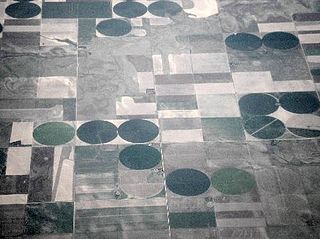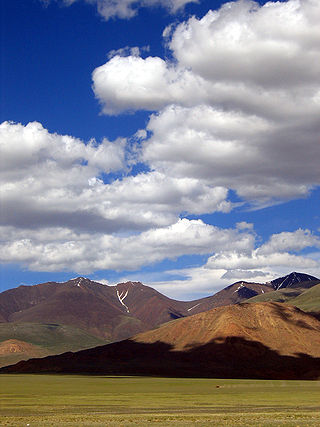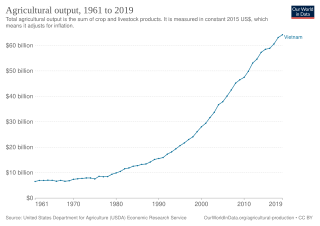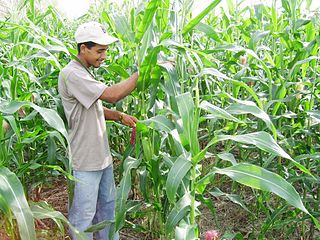
A farm is an area of land that is devoted primarily to agricultural processes with the primary objective of producing food and other crops; it is the basic facility in food production. The name is used for specialized units such as arable farms, vegetable farms, fruit farms, dairy, pig and poultry farms, and land used for the production of natural fiber, biofuel, and other commodities. It includes ranches, feedlots, orchards, plantations and estates, smallholdings, and hobby farms, and includes the farmhouse and agricultural buildings as well as the land. In modern times, the term has been extended so as to include such industrial operations as wind farms and fish farms, both of which can operate on land or at sea.

The Common Agricultural Policy (CAP) is the agricultural policy of the European Union. It implements a system of agricultural subsidies and other programmes. It was introduced in 1962 and has since then undergone several changes to reduce the EEC budget cost and consider rural development in its aims. It has however, been criticised on the grounds of its cost, its environmental, and humanitarian effects.
Huge changes in agricultural practice were instituted under the Czechoslovak Socialist Republic. 95% of all privately owned companies were nationalized, and 95% of farms were nationalized. No one could own more than 50 hectares of land. Collectivization worked for some but not others. Larger farms were organized on 3 levels of hierarchy which actually reduced worker participation in decision making. A massive trend during the early part of the collectivization period was that younger workers left for better jobs in the cities and productivity fell. Reforms in the 1970s saw more investment and improvements began to appear gradually. There were record harvests in the 1980s.

A smallholding or smallholder is a small farm operating under a small-scale agriculture model. Definitions vary widely for what constitutes a smallholder or small-scale farm, including factors such as size, food production technique or technology, involvement of family in labor and economic impact. Smallholdings are usually farms supporting a single family with a mixture of cash crops and subsistence farming. As a country becomes more affluent, smallholdings may not be self-sufficient, but may be valued for the rural lifestyle. As the sustainable food and local food movements grow in affluent countries, some of these smallholdings are gaining increased economic viability. There are an estimated 500 million smallholder farms in developing countries of the world alone, supporting almost two billion people.

Agriculture in Mongolia constitutes over 10% of Mongolia's annual gross domestic product and employs one-third of the labor force. However, the high altitude, extreme fluctuation in temperature, long winters, and low precipitation provides limited potential for agricultural development. The growing season is only 95 – 110 days. Because of Mongolia's harsh climate, it is unsuited to most cultivation.

Agriculture in South Korea is a sector of the economy of South Korea. Korean agriculture is the basic industry of the Korean economy, consisting of farming, animal husbandry, forestry and fishing. At the time of its founding, Korea was a typical agricultural country, with more than 80% of the population engaged in agricultural production. After land reform under the Lee Seung-man administration, economic revitalization under the Park Chung-hee military government and the wave of world trade liberalization that began in the 1980s, Korean agriculture has undergone dramatic changes. Through the Green Revolution, Korea became self-sufficient in rice, the staple food, in 1978, and in 1996, Korea became the first Asian country after Japan to mechanize its agriculture with fine-grained cultivation. The development of Korean agriculture has also led to the development of agriculture-related industries such as fertilizer, agricultural machinery and seed.

In 2004, agriculture and forestry accounted for 21.8 percent of Vietnam's gross domestic product (GDP), and between 1994 and 2004, the sector grew at an annual rate of 4.1 percent. Agriculture's share of economic output has declined in recent years, falling as a share of GDP from 42% in 1989 to 26% in 1999, as production in other sectors of the economy has risen. However, agricultural employment was much higher than agriculture's share of GDP; in 2005, approximately 60 percent of the employed labor force was engaged in agriculture, forestry, and fishing. Agricultural products accounted for 30 percent of exports in 2005. The relaxation of the state monopoly on rice exports transformed the country into the world's second or third largest rice exporter. Other cash crops are coffee, cotton, peanuts, rubber, sugarcane, and tea.

For millennia, agriculture has played an important role in the Chinese economy and society. By the time the People's Republic of China was established in 1949, virtually all arable land was under cultivation; irrigation and drainage systems constructed centuries earlier and intensive farming practices already produced relatively high yields. But little prime virgin land was available to support population growth and economic development. However, after a decline in production as a result of the Great Leap Forward (1958–60), agricultural reforms implemented in the 1980s increased yields and promised even greater future production from existing cultivated land.

Agriculture in Ethiopia is the foundation of the country's economy, accounting for half of gross domestic product (GDP), 83.9% of exports, and 80% of total employment.
Agriculture continued to be the mainstay of the economy of Haiti in the late 1980s; it employed approximately 66 percent of the labor force and accounted for about 35 percent of GDP and for 24 percent of exports in 1987. The role of agriculture in the economy has declined severely since the 1950s, when the sector employed 80 percent of the labor force, represented 50 percent of GDP, and contributed 90 percent of exports. Many factors have contributed to this decline. Some of the major ones included the continuing fragmentation of landholdings, low levels of agricultural technology, migration out of rural areas, insecure land tenure, a lack of capital investment, high commodity taxes, the low productivity of undernourished animals, plant diseases, and inadequate infrastructure. Neither the government nor the private sector invested much in rural ventures; in FY 1989 only 5 percent of the national budget went to the Ministry of Agriculture, Natural Resources, and Rural Development. As Haiti entered the 1990s, however, the main challenge to agriculture was not economic, but ecological. Extreme deforestation, soil erosion, droughts, flooding, and the ravages of other natural disasters had all led to a critical environmental situation.
The agricultural policy of the United States is composed primarily of the periodically renewed federal U.S. farm bills. The Farm Bills have a rich history which initially sought to provide income and price support to US farmers and prevent them from adverse global as well as local supply and demand shocks. This implied an elaborate subsidy program which supports domestic production by either direct payments or through price support measures. The former incentivizes farmers to grow certain crops which are eligible for such payments through environmentally conscientious practices of farming. The latter protects farmers from vagaries of price fluctuations by ensuring a minimum price and fulfilling their shortfalls in revenue upon a fall in price. Lately, there are other measures through which the government encourages crop insurance and pays part of the premium for such insurance against various unanticipated outcomes in agriculture.

The role of agriculture in the Bolivian economy in the late 1980s expanded as the collapse of the tin industry forced the country to diversify its productive and export base. Agricultural production as a share of GDP was approximately 23 percent in 1987, compared with 30 percent in 1960 and a low of just under 17 percent in 1979. The recession of the 1980s, along with unfavorable weather conditions, particularly droughts and floods, hampered output. Agriculture employed about 46 percent of the country's labor force in 1987. Most production, with the exception of coca, focused on the domestic market and self-sufficiency in food. Agricultural exports accounted for only about 15 percent of total exports in the late 1980s, depending on weather conditions and commodity prices for agricultural goods, hydrocarbons, and minerals.

Agriculture in Jordan contributed substantially to the economy at the time of Jordan's independence, but it subsequently suffered a decades-long steady decline. In the early 1950s, agriculture constituted almost 40 percent of GNP; on the eve of the Six-Day War, it was 17 percent.

Agriculture in Cyprus constituted the backbone of its economy when it achieved its independence in 1960. It mostly consisted of small farms, and sometimes even subsistence farms. During the 1960s, irrigation projects made possible vegetable and fruit exports; increasingly commercialized farming was able to meet the demands for meat, dairy products, and wine from the British and United Nations troops stationed on the island and from the growing number of tourists.

Agriculture in Panama is an important sector of the Panamanian economy. Major agricultural products include bananas, cocoa beans, coffee, coconuts, timber, beef, chicken, shrimp, corn, potatoes, rice, soybeans, and sugar cane.
Prior to World War II, agriculture in Bulgaria was the leading sector in the Bulgarian economy. In 1939, agriculture contributed 65 percent of Net material product (NMP), and four out of every five Bulgarians were employed in agriculture. The importance and organization of Bulgarian agriculture changed drastically after the war, however. By 1958, the Bulgarian Communist Party (BCP) had collectivized a high percentage of Bulgarian farms; in the next three decades, the state used various forms of organization to improve productivity, but none succeeded. Meanwhile, private plots remained productive and often alleviated agricultural shortages during the Todor Zhivkov era.
Despite the crisis in Syria, agriculture remains a key part of the economy. The sector still accounts for an estimated 26 percent of gross domestic product (GDP) and represents a critical safety net for the 6.7 million Syrians – including those internally displaced – who still remain in rural areas. However, agriculture and the livelihoods that depend on it have suffered massive losses . Today, food production is at a record low and around half the population remaining in Syria are unable to meet their daily food needs.

Agriculture in Saudi Arabia is focused on the export of dates, dairy products, eggs, fish, poultry, fruits, vegetables, and flowers to markets around the world as it has achieved self-sufficiency in the production of such products. The government of Saudi Arabia is heavily involved in the agriculture industry and subsidizing corporate farming and the Ministry of Environment, Water and Agriculture is primarily responsible for the agricultural policies in the nation. The private sector also plays a role in the nation's agriculture, as the government offers long-term interest-free loans and low-cost water, fuel, electricity, and duty-free imports of raw materials and machinery.
Farm programs can be part of a concentrated effort to boost a country’s agricultural productivity in general or in specific sectors where they may have a comparative advantage. There are many different types of farm programs, with a variety of objectives and created with different economic mechanisms in mind. Some are meant to benefit farmers directly, while others seek to benefit consumers. They target food prices and quantity of food available on the market, as well as production and consumption of certain goods. Some are meant to benefit farmers directly, while others seek to benefit consumers. They target food prices and quantity of food available on the market, as well as production and consumption of certain goods.
In the agricultural context, diversification can be regarded as the re-allocation of some of a farm's productive resources, such as land, capital, farm equipment and labour to other products and, particularly in richer countries, to non-farming activities such as restaurants and shops. Factors leading to decisions to diversify are many, but include: reducing risk, responding to changing consumer demands or changing government policy, responding to external shocks and, more recently, as a consequence of climate change.













